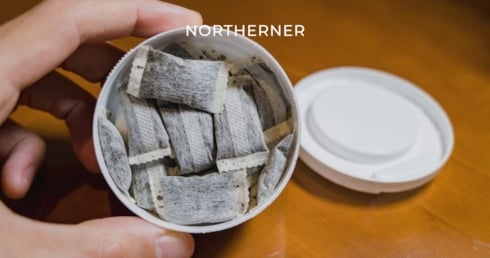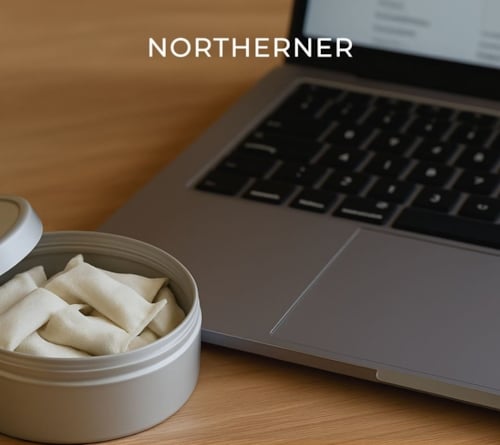Published 2022-05-09
Last update 2025-03-31
What Is Snus?
Snus (pronounced "snoose") is a moist, smokeless nicotine product that originated in Sweden. Traditionally, snus contains ground tobacco, water, salt, and flavourings. Unlike cigarettes, it is not burned but instead placed under the upper lip, where nicotine is absorbed through the oral mucosa.

Key Points
- Snus is a smokeless nicotine product that originated in Sweden, designed to be placed under the upper lip for nicotine absorption.
- It comes in two forms: Swedish snus (which contains tobacco) and tobacco-free snus (also called nicotine pouches).
- The sale of tobacco snus is banned in the UK, but tobacco-free snus (nicotine pouches) is legally available.
What Exactly Is Snus?
Snus is a tobacco product that is placed under the upper lip, allowing the nicotine to be absorbed through the oral mucosa and into the bloodstream.
Snus is composed of air-dried ground tobacco. It also contains water, salt, flavouring, and other taste additives. This mixture results in a moist, powdered product that can be either loose or contained in small pouches.
Snus vs. Tobacco-Free Snus in the UK
In Sweden, "snus" refers specifically to tobacco-based snus. However, in the UK, many people use the word "snus" to refer to both tobacco snus and tobacco-free alternatives, such as nicotine pouches.
Since tobacco snus is banned in the UK, those looking for a similar product can legally buy tobacco-free snus pouches, also known as nicotine pouches. These pouches contain nicotine but no tobacco, offering a similar experience without the use of tobacco leaves.
Learn more about the products: Snus vs. Nicotine Pouches – What’s the Difference?
Snus comes in two primary forms:
- Swedish Snus (contains tobacco, the sale of snus is banned in the UK under the Tobacco and Related Products Act 2016)
- Tobacco-Free Snus (Nicotine Pouches) (legal in the UK, made without tobacco)
Despite the legal differences, tobacco-free snus (nicotine pouches) is legally available in the UK for those looking for a tobacco-free nicotine product. Snus comes in different varieties, including flavoured snus options.
What Are the Different Types of Snus?
Snus is available in different formats:
| Type | Format | Flavour Profile | Moisture Level | Available in the UK? |
|---|---|---|---|---|
| Swedish Snus | Finely ground tobacco in pouches | Primarily tobacco flavour, sometimes flavoured | Moist | No |
| Loose Snus | Finely ground tobacco in loose form | Primarily tobacco flavour, sometimes flavoured | Moist | No |
| Tobacco-free Snus | Nicotine without tobacco, in pouches | Mint, citrus, and other added flavours | Varies | Yes |
Learn about the different types of snus and their characteristics.
How Is Snus Made?
Swedish snus is made using a specific pasteurisation process to reduce bacteria while maintaining moisture levels. Meanwhile, tobacco-free snus (nicotine pouches) undergoes a similar production process but replaces tobacco with a nicotine-infused plant-based fibre.
The History of Snus: From Sweden to the UK
Snus has been a part of Swedish culture for centuries. Here’s how it evolved:
- 16th Century – Snus was first introduced to Sweden, originally used as a luxury product by the upper class.
- 18th Century – Swedish manufacturers began producing snus locally, increasing accessibility.
- 20th Century – Sweden regulated snus production to maintain quality, leading to modern Swedish snus standards.
- 1992 – The EU banned the sale of tobacco snus (except in Sweden).
- 2019 – Tobacco-free snus (nicotine pouches) became available in the UK, offering an alternative to traditional snus.
Today, snus remains popular in Sweden, while in the UK, consumers have increasingly turned to tobacco-free nicotine pouches since their introduction in 2019.
Learn more about the legalities of snus in our article: Is Snus Legal in the UK?
Rise of Snus in the UK
Snus has a complex history in the UK. Swedish immigrants introduced it in the 19th century, but it remained relatively unknown outside of Scandinavian communities.
However, since 1992, the sale of tobacco snus has been banned across the European Union (including the UK).
Recognising a growing demand for an alternative, tobacco-free snus (nicotine pouches) entered the UK market in 2019. These pouches offer a tobacco-free option for those seeking an alternative experience, and they are legal to purchase.
A 2022 survey commissioned by Action on Smoking and Health (ASH) found that 0.7% of UK adults—about 368,000 people—were using nicotine pouches. This figure highlights the rising awareness and demand.
Learn More About Snus
For information on topics such as how to use snus, its legal status, and its effects, check out our related articles:
Frequently Asked Questions about Snus
Is snus legal in the UK?
The sale of tobacco snus is banned in the UK and the European Union (except Sweden) under the Tobacco and Related Products Act 2016. However, tobacco-free snus (nicotine pouches) is legal and widely available.
Does snus contain nicotine?
Yes, both traditional snus and tobacco-free snus contain nicotine. The strength varies depending on the brand and type.
How long does snus last?
A portion of snus typically lasts 20 to 60 minutes, depending on its moisture level and personal preference. Read this guide on how to use snus.
Does snus stain teeth?
Tobacco-based snus can cause staining due to its nicotine and tobacco content. Tobacco-free nicotine pouches, being all-white, are less likely to cause staining.
What is the strongest snus?
Some brands, such as Siberia, White Fox, and ELF, offer extra-strong snus with high nicotine levels. Compare the strongest snus and nicotine pouches available.
Related articles




